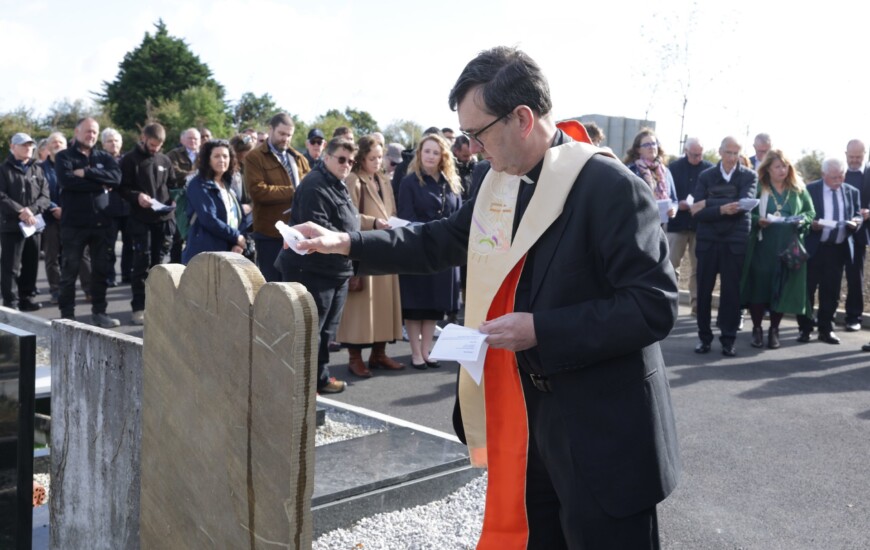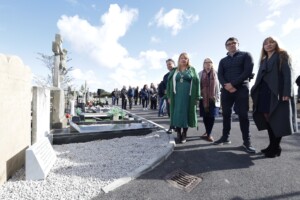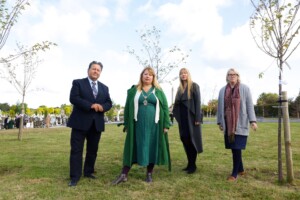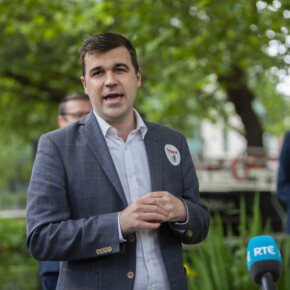Remains of 1,617 cholera victims buried in Glasnevin Cemetery
Padraig Conlon 19 Sep 2024
The remains of more than 1,600 people who died during the Cholera Pandemic of 1832 have been reinterred in Glasnevin Cemetery.
Transport Infrastructure Ireland (TII) and the Directors of Dublin Cemeteries Trust welcomed Deputy Lord Mayor, Councillor Donna Cooney and other guests to a ceremony at Glasnevin Cemetery last Thursday (12th) to mark the reinterment of the remains of the 1832 Cholera Pandemic victims, found during the Luas Cross City works.

The Deputy Lord Mayor unveiled a new headstone, to remember these forgotten victims of a sad episode in Dublin’s history, and formally opened an exhibition about this significant tragic historic event.
During the extensive excavations that were undertaken as part of Luas Cross City, 1,617 individuals were recovered, comprising 34 articulated burials and over 19,200 disarticulated bones.
In 2010 the Luas Cross City (LCC) Environmental Impact Assessment Report identified Grangegorman Laneway as a potential location of a cholera graveyard dating to the 1832 Cholera Pandemic. Cholera is an infectious disease caused by the bacterium vibrio cholerae.
It is contracted from ingesting contaminated food or water. The primary effect of the disease is acute diarrhoea leading to severe dehydration and death within 24 hours.
The 1832 Cholera Pandemic was part of a second cholera pandemic (the first occurring from 1817-1823).
The second pandemic spread westwards from Russia across Europe. In mid-March 1832, the disease reached Ireland subsiding in December of that year, only for the disease to re-emerge in 1848 at the height of the Great Famine, until finally ending in 1850.
The overall Irish death toll from March to December 1832 was around 25,378. Over 11,000 people in Dublin were infected during this period, between 5,079 – 6,000 of whom passed away.
To address the disease and care for the sick the Richmond Female Penitentiary in Grangegorman, which had just closed, was proposed for use as the ‘Dublin Cholera Hospital’ and began accepting patients in April 1832, with nursing support provided by the Sisters of Charity.
Victims of the disease were initially buried in Bully’s Acre, Kilmainham, but this quickly reached capacity and a new burial ground was urgently required.
Correspondence indicates that the Richmond Penitentiary gardens came into use as a cholera burial ground in May 1832.

There had always been some uncertainty as to the exact location of the cemetery.
Records show that the Midland Great Western Railway (MGWR) purchased 3 acres of these Penitentiary lands in the 1870s to facilitate expansion of their adjacent Broadstone railyard (the former MGWR terminus).
Accounts of these expansion works noted that burials had been disturbed, exhumed and reinterred in a ‘patch of ground’, without identifying a definitive location.
In 2015 archaeological test excavations for Luas Cross City identified two charnel trenches containing disarticulated human remains within the laneway leading from Grangegorman to Broadstone.
Full archaeological excavation (from October 2015 to February 2016) and specialist post-excavation analysis (from 2016-2021) were undertaken by Rubicon Heritage Services Ltd. for SISK Steconfer Joint Venture Ltd (SSJV) on behalf of TII.
Due to the age and nature of the assemblage, it has not been possible to identify any of the individuals, but a single headstone was recovered with the following inscription: Here lies the earthly remains of Anthony Donlevy who died 28th July 1832 this small tribute of affection is erected to his memory by his beloved wife Jane Donlevy.
Research indicates Anthony was born in Cliffony, Sligo and married his wife in Kilcullen, Kildare in April 1798.
This headstone was also erected at Glasnevin Cemetery, in tribute both to Janes love of Anthony, and as a mark of respect for all others who lost loved ones during this time.
The excavation of the cemetery was an extremely difficult task for all involved, particularly due to the nature of human tragedy the works represented.
From the outset it has been the wish of TII to ensure these individuals were treated with the utmost respect.
Through this formal burial in consecrated ground, it is the intention of TII and Glasnevin Cemeteries Trust that the dignity of these individuals is restored, that their loss is never forgotten, and that they may now truly Rest in Peace.

Pictured at the ceremony to mark the reinterment of the remains of the 1832 Cholera victims found during the Luas Cross City Works: L to R, Engin Sinopluoglu TII, Deputy Lord Mayor Donna Cooney, Aoife Watters Dublin Cemeteries Trust and Emer Dennehy TII Archaeologist.
Speaking at the event Deputy Lord Mayor, Councillor Donna Cooney said:
“It is a great honour to be invited here today to unveil the plaque to honour the victims of the Cholera Pandemic, to officially open the exhibition and to finally see these people’s remains laid to rest in this beautiful cemetery, may they rest in peace”.











